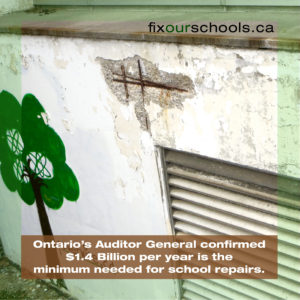In this COVID-pandemic, science tells us that being outdoors is the safest place and, when students, teachers, and education workers need to be inside classrooms, the next best thing is lots of fresh air. In the June 2020 SickKids entitled, “COVID-19: Recommendations for School Reopening”, proper ventilation was cited as an important element of a safe return to school.
“Adequately ventilated classroom environments (e.g. open windows with air flow, and improved airflow through ventilation systems) are expected to be associated with less likelihood of transmission compared with poorly ventilated settings.”
By early August 2020, the Public Health Agency of Canada had issued its own guidelines for safe school reopenings, which also clearly outlined the importance of good ventilation. It called upon schools to increase ventilation by opening windows when possible, and increasing air exchanges by adjusting HVAC systems.
Prior to the pandemic, $16.3-billion of disrepair existed in Ontario’s publicly funded schools. Across the province, there were (and are!) classrooms with no windows, windows that do not open at all or that only open a tiny bit, and some older schools and portables without HVAC systems to bring in fresh air from outside. Add to this reality, the lack of provincial funding – the only source of funding for schools and education in Ontario – and one can appreciate the challenging position in which Ontario’s school boards found themselves over the summer. In fact, only in late August did Ontario’s Education Minister Lecce announce a mere $50-million in provincial funding for school boards to use to improve ventilation in schools to prevent transmission of COVID-19.
Ontario’s school boards took health advice about improving ventilation very seriously. Knowing that they would be held accountable if ventilation was not improved in their schools by September, they began work well before the provincial government had made a commitment to fund this required work. The Hamilton-Wentworth District School Board (HWDSB) clearly and transparently shares the steps taken to ensure proper ventilation in its classrooms, even including specific reports on each school. The Toronto District School Board (TDSB) also worked over the summer to review and improve ventilation and increase the volume of fresh air. The Ottawa-Carleton District School Board (OCDSB) was also inspecting schools and ventilation systems over the summer to ensure they’re functioning as designed, and making repairs as required. The Toronto Catholic District School Board (TCDSB) even went so far over the summer as to modify vertical sliding windows, as needed, to increase the opening from 4 inches to 12 inches, acknowledging the important role of natural ventilation provided through opening windows.
Fast forward to September 2020. Many of Ontario’s students did return to classrooms. However, a significant percentage of families (particularly in areas hardest hit by COVID) opted for at-home learning, feeling that amidst high community spread – a return to in-class learning was simply not a safe or healthy choice. Despite the inevitable COVID cases that have emerged in Ontario’s schools since September, in-class learning has been able to continue. Amidst the second wave, and heading into colder months, ventilation continues to be a critical component of limiting transmission of COVID in classrooms.
Toronto Public Health issued a revised COVID Fact Sheet in early November, which is being used by both the TDSB and the Toronto Catholic Board (TCDSB) to inform their COVID protocols, including those related to ventilation. The TDSB has been extremely transparent about its assessments of all classrooms to determine whether they benefited from mechanical ventilation, or would be receiving a HEPA Unit to provide a degree of mechanical ventilation to augment natural ventilation in that classroom.
The TDSB also recently sent the following email to all families, emphasizing the importance of ventilation through both mechanical and natural means in the coming months:
“Dear Parents and Guardians,
The TDSB continues to do everything we can to help slow the spread of COVID-19. Daily self-assessments, regular hand washing, mask-wearing, and physical distancing are some of the most important things we can do. In addition, according to Toronto Public Health, increasing fresh air is an important strategy in our schools and classrooms.
Over the past few months, the TDSB has checked all mechanical HVAC systems to ensure they are operating as designed, increased the frequency of filter changes, adjusted systems to increase the amount of fresh air and reduce recirculation, added portable HEPA air filter units in classrooms where mechanical ventilation is not an option, and opened windows where possible.
As we head into the colder months of the year, open windows will continue to be an important step to increase fresh air in classrooms and schools. Toronto Public Health is recommending that windows in classrooms should be opened for a period of time, at different points of the day to introduce fresh air into the space and increase airflow. While heating systems will be turned up, we still expect that schools will be cooler than normal.
We recognize it is very much a balance between introducing more ventilation at various times during the day and maintaining a comfortable indoor air temperature in classrooms. Please keep this in mind as your child gets ready for school each day by considering an extra layer of clothing to ensure comfort throughout the day.”
Looking outside of Canada, Fix Our Schools noted that the German Environment Agency (UBA) has provided a detailed instruction manual for ventilation in schools, recommending that classrooms ought to be aired regularly every 20 minutes for about 5 minutes with the windows wide open, which ensures the air is completely swapped for fresh air from outside three times an hour. In fact, the practice of opening windows for fresh air for several minutes, known as Lüftung in German, is something of a national obsession in the country.
Experts in indoor air quality such as Jeffrey Siegel, a professor of civil engineering at the University of Toronto, note that ensuring good indoor air quality can help reduce the transmission of COVID-19. He also notes that even once we move past this global pandemic, “there is overwhelming evidence that addressing ventilation in schools improves academic performance, decreases absenteeism, and reduces asthma. When you total up all the economic benefits, it’s an economic no-brainer.”
With all of this in mind, Fix Our Schools suggests that Ontario’s students, teachers, and education workers would be well-served by a concerted effort to optimize indoor air quality through a combination of mechanical and natural ventilation. We would also suggest that without a provincially funded program in place to test classroom air quality regularly, we will never know for certain the quality of indoor air in our classrooms.



